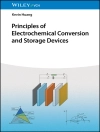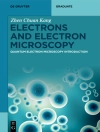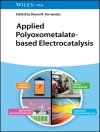Meeting the need for a text on solutions to conditions which have so far been a drawback for this important and trend-setting technology, this monograph places special emphasis on novel, alternative catalysts of low temperature fuel cells. Comprehensive in its coverage, the text discusses not only the electrochemical, mechanistic, and material scientific background, but also provides extensive chapters on the design and fabrication of electrocatalysts.
A valuable resource aimed at multidisciplinary audiences in the fields of academia and industry.
Jadual kandungan
List of Contributors xvii
Preface xxiii
1 Principle of Low-temperature Fuel Cells Using an Ionic Membrane 1
Claude Lamy
1.1 Introduction 1
1.2 Thermodynamic Data and Theoretical Energy Efficiency under Equilibrium (j= 0) 2
1.3 Electrocatalysis and the Rate of Electrochemical Reactions 8
1.4 Influence of the Properties of the PEMFC Components (Electrode Catalyst Structure, Membrane Resistance, and Mass Transfer Limitations) on the Polarization Curves 16
1.5 Representative Examples of Low-temperature Fuel Cells 19
1.6 Conclusions and Outlook 30
Acknowledgments 31
References 31
2 Research Advancements in Low-temperature Fuel Cells 35
N. Rajalakshmi, R. Imran Jafri, and K.S. Dhathathreyan
2.1 Introduction 35
2.2 Proton Exchange Membrane Fuel Cells 38
2.3 Alkaline Fuel Cells 50
2.4 Direct Borohydride Fuel Cells 59
2.5 Regenerative Fuel Cells 62
2.6 Conclusions and Outlook 64
Acknowledgments 65
References 65
3 Electrocatalytic Reactions Involved in Low-temperature Fuel Cells 75
Claude Lamy
3.1 Introduction 75
3.2 Preparation and Characterization of Pt-based Plurimetallic Electrocatalysts 76
3.3 Mechanisms of the Electrocatalytic Reactions Involved in Lowtemperature Fuel Cells 90
3.4 Conclusions and Outlook 105
Acknowledgment 106
References 106
4 Direct Hydrocarbon Low-temperature Fuel Cell 113
Ayan Mukherjee and Suddhasatwa Basu
4.1 Introduction 113
4.2 Direct Methanol Fuel Cell 114
4.3 Direct Ethanol Fuel Cell 119
4.4 Direct Ethylene Glycol Fuel Cell 125
4.5 Direct Formic Acid Fuel Cell 129
4.6 Direct Glucose Fuel Cell 131
4.7 Commercialization Status of DHFC 132
4.8 Conclusions and Outlook 134
References 137
5 The Oscillatory Electrooxidation of Small Organic Molecules 145
Hamilton Varela, Marcelo V.F. Delmonde, and Alana A. Zülke
5.1 Introduction 145
5.2 In Situ and Online Approaches 147
5.3 The Effect of Temperature 152
5.4 Modified Surfaces 155
5.5 Conclusions and Outlook 157
Acknowledgments 157
References 158
6 Degradation Mechanism of Membrane Fuel Cells with Monoplatinum and Multicomponent Cathode Catalysts 165
Mikhail R. Tarasevich and Vera A. Bogdanovskaya
6.1 Introduction 165
6.2 Synthesis and Experimental Methods of Studying Catalytic Systems under Model Conditions 166
6.3 Characteristics of Commercial and Synthesized Catalysts 169
6.4 Methods of Testing Catalysts within FC MEAs 179
6.5 Mechanism of Degradation Phenomenon in MEAs with Commercial Pt/C Catalysts 181
6.6 Characteristics of MEAs with 40Pt/CNT-T-based Cathode 187
6.7 Characteristics of MEAs with 50Pt Co Cr/C-based Cathodes 188
6.8 Conclusions and Outlook 192
Acknowledgments 193
References 193
7 Recent Developments in Electrocatalysts and Hybrid Electrocatalyst Support Systems for Polymer Electrolyte Fuel Cells 197
Surbhi Sharma
7.1 Introduction 197
7.2 Current State of Pt and Non-Pt Electrocatalysts Support Systems for PEFC 197
7.3 Novel Pt Electrocatalysts 199
7.4 Pt-based Electrocatalysts on Novel Carbon Supports 203
7.5 Pt-based Electrocatalysts on Novel Carbon-free Supports 207
7.6 Pt-free Metal Electrocatalysts 213
7.7 Influence of Support: Electrocatalyst–Support Interactions and Effect of Surface Functional Groups 214
7.8 Hybrid Catalyst Support Systems 218
7.9 Conclusions and Outlook 223
References 224
8 Role of Catalyst Supports: Graphene Based Novel Electrocatalysts 241
Chunmei Zhang and Wei Chen
8.1 Introduction 241
8.2 Graphene-based Cathode Catalysts for Oxygen Reduction Reaction 243
8.3 Graphene-based Anode Catalysts 250
8.4 Conclusions and Outlook 256
Acknowledgment 256
References 257
9 Recent Progress in Nonnoble Metal Electrocatalysts for Oxygen Reduction for Alkaline Fuel Cells 267
Qinggang He and Xin Deng
9.1 Introduction 267
9.2 Nonnoble Metal Electrocatalysts 272
9.3 Conclusions and Outlook 296
References 299
10 Anode Electrocatalysts for Direct Borohydride and Direct Ammonia Borane Fuel Cells 317
Pierre-Yves Olu, Anicet Zadick, Nathalie Job, and Marian Chatenet
10.1 Introduction 317
10.2 Direct Borohydride (and Ammonia Borane) Fuel Cells 318
10.2.1 Basics of DBFC and DABFC 318
10.2.2 Main Issues of the DBFC and DABFC 319
10.3 Mechanistic Investigations of BOR and BH3OR at Noble Electrocatalysts 320
10.4 Toward Ideal Anode of DBFC and DABFC 329
10.5 Durability of DBFC and DABFC Electrocatalysts 336
10.6 Conclusions and Outlook 339
References 340
11 Recent Advances in Nanostructured Electrocatalysts for Lowtemperature Direct Alcohol Fuel Cells 347
Srabanti Ghosh, Thandavarayan Maiyalagan, and Rajendra N. Basu
11.1 Introduction 347
11.2 Fundamentals of Electrooxidation of Organic Molecules for Fuel Cells 348
11.3 Investigation of Electrocatalytic Properties of Nanomaterials 352
11.4 Anode Electrocatalysts for Direct Methanol or Ethanol Fuel Cells 353
11.5 Anode Catalysts for Direct Polyol Fuel Cells (Ethylene Glycol and Glycerol) 359
11.6 Conclusions and Outlook 361
References 362
12 Electrocatalysis of Facet-controlled Noble Metal Nanomaterials for Low-temperature Fuel Cells 373
Xiaojun Liu, Wenyue Li, and Shouzhong Zou
12.1 Introduction 373
12.2 Synthesis of Shape-controlled Noble Metal Nanomaterials 374
12.3 Applications of Shape-controlled Noble Metal Nanomaterials as Catalysts for Low-temperature Fuel Cells 383
12.4 Conclusions and Outlook 389
Acknowledgment 390
References 390
13 Heteroatom-doped Nanostructured Carbon Materials as ORR Electrocatalysts for Low-temperature Fuel Cells 401
Thandavarayan Maiyalagan, Subbiah Maheswari, and Viswanathan S. Saji
13.1 Introduction 401
13.2 Oxygen Reduction Reaction and Methanol-tolerant ORR Catalysts 402
13.3 Heteroatom-doped Nanostructured Carbon Materials 403
13.4 Heteroatom-doped Carbon-based Nanocomposites 415
13.5 Conclusions and Outlook 416
References 417
14 Transition Metal Oxide, Oxynitride, and Nitride Electrocatalysts with and without Supports for Polymer Electrolyte Fuel Cell Cathodes 423
Mitsuharu Chisaka
14.1 Introduction 423
14.2 Transition Metal Oxide and Oxynitride Electrocatalysts 424
14.3 Transition Metal Nitride Electrocatalysts 433
14.4 Carbon Support-Free Electrocatalysts 434
14.5 Conclusions and Outlook 435
Acknowledgment 436
References 436
15 Spectroscopy and Microscopy for Characterization of Fuel Cell Catalysts 443
Chilan Ngo, Michael J. Dzara, Sarah Shulda, and Svitlana Pylypenko
15.1 Introduction 443
15.2 Electron Microscopy 444
15.3 Electron Spectroscopy: Energy-dispersive Spectroscopy and Electron Energy Loss Spectroscopy 449
15.4 X-ray Spectroscopy 451
15.5 Gamma Spectroscopy: Mossbauer 455
15.6 Vibrational Spectroscopy: Fourier Transform Infrared Spectroscopy and Raman Spectroscopy 456
15.7 Complementary Techniques 459
15.8 Conclusions and Outlook 462
16 Rational Catalyst Design Methodologies: Principles and Factors Affecting the Catalyst Design 467
Sergey Stolbov and Marisol Alcántara Ortigoza
16.1 Introduction 467
16.2 Oxygen Reduction Reaction 468
16.3 Recent Progress in Search for Efficient ORR Catalysts 469
16.4 Physics and Chemistry behind ORR 471
16.5 Rational Design of ORR Catalysts 475
16.6 Rationally Designed ORR Catalysts Addressing Cost-effectiveness 482
16.7 Conclusions and Outlook 483
References 483
17 Effect of Gas Diffusion Layer Structure on the Performance of Polymer Electrolyte Membrane Fuel Cell 489
Branko N. Popov, Sehkyu Park, and Jong-Won Lee
17.1 Introduction 489
17.2 Structure of Gas Diffusion Layer 490
17.3 Carbon Materials 493
17.4 Hydrophobic and Hydrophilic Treatments 494
17.5 Microporous Layer Thickness 499
17.6 Microstructure Modification 500
17.7 Conclusions and Outlook 500
Acknowledgment 505
References 505
18 Efficient Design and Fabrication of Porous Metallic Electrocatalysts 511
Yaovi Holade, Anaïs Lehoux, Hynd Remita, Kouakou B. Kokoh, and Têko W. Napporn
18.1 Introduction 511
18.2 Advances in the Design and Fabrication of Mesoporous Metallic Materials 512
18.3 Nanoporous Metallic Materials at Work in Electrocatalysis 520
18.4 Conclusions and Outlook 526
References 527
19 Design and Fabrication of Dealloying-driven Nanoporous Metallic Electrocatalyst 533
Zhonghua Zhang and Wang Ying
19.1 Introduction 533
19.2 Design of Precursors for Dealloying-driven Nanoporous Metallic Electrocatalysts 535
19.3 Microstructural Modulation of Dealloying-driven Nanoporous Metallic Electrocatalysts 538
19.4 Catalytic Properties of Dealloying-driven Nanoporous Metallic Electrocatalysts 542
19.5 Conclusions and Outlook 551
Acknowledgments 551
References 551
20 Recent Advances in Platinum Monolayer Electrocatalysts for the Oxygen Reduction Reaction 557
Kotaro Sasaki, Kurian A. Kuttiyiel, Jia X. Wang, Miomir B. Vukmirovic, and Radoslav R. Adzic
20.1 Introduction 557
20.2 Pt ML on Pd Core Electrocatalysts (Pt ML/Pd/C) 558
20.3 Pt ML on Pd Au Core Electrocatalyst (Pt ML/Pd Au/C) 564
20.4 Further Improving Activity and Stability of Pt ML Electrocatalysts 570
20.5 Conclusions and Outlook 579
Acknowledgments 579
References 580
Index 585
Mengenai Pengarang
Thandavarayan Maiyalagan is currently an Associate Professor of the Department of Chemistry at SRM University, Kattankulathur, India. He received his Ph.D in Physical Chemistry from the Indian Institute of Technology, Madras, and completed postdoctoral programs at Newcastle University (UK), Nanyang Technological University (Singapore) and at the University of Texas, Austin (USA). His main research interests concern new materials and their electrochemical properties for energy conversion and storage devices, electrocatalysts, fuel cells and biosensors. He has delivered various key lectures in many national and international forums. He has published over 80 articles on the innovative design of the materials for energy conversion and storage.
Viswanathan S. Saji received his Ph.D. (2003) degree from the University of Kerala, India and was a Research Associate at the Indian Institute of Technology, Bombay (2004-2005) and the Indian Institute of Science, Bangalore (2005-2007). Later, he moved to South Korea where he was a Postdoctoral Researcher at Yonsei University (2007-2008) and Sunchon National University (2009), Research Professor at Chosun University (2008-2009), Senior Research Scientist at Ulsan National Institute of Science and Technology (2009-2010) and Research Professor at Korea University (2010-2013). In 2014, he joined the University of Adelaide, where he was an Endeavour Research Fellow in the School of Chemical Engineering. Presently, he is working as an Executive Director to CIOSHI, Kerala, India.












